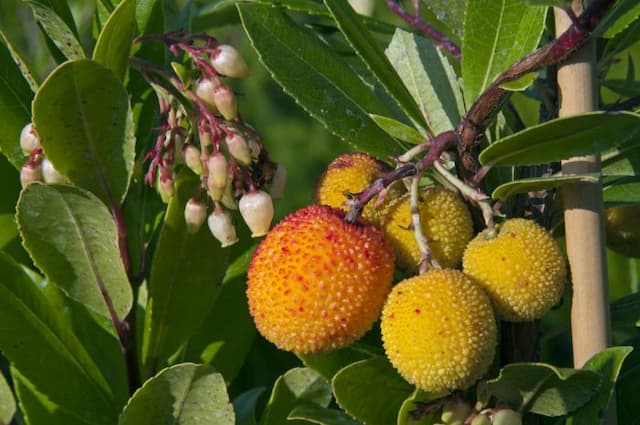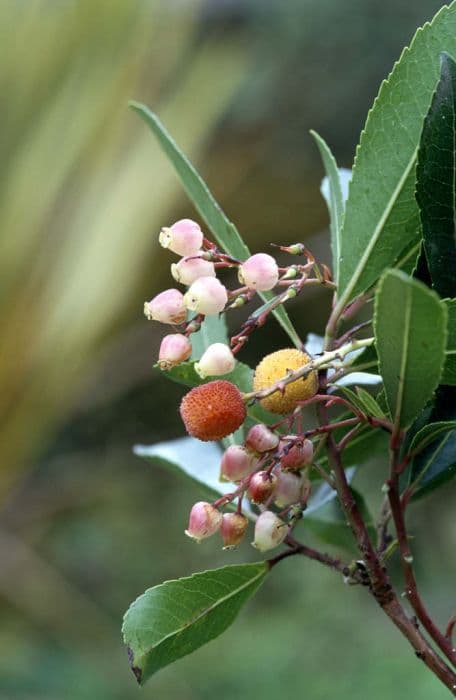Rhododendron Rhododendron 'Mrs J.c. Williams'

ABOUT
Rhododendron 'Mrs. J.C. Williams' showcases an alluring appearance characterized by an intricate display of flowers and foliage. The flowers are notable for their striking colors, often a vibrant shade that draws the eye. They possess a trumpet-like form that tends to cluster in large, showy blooms, creating a lush inflorescence that is visually appealing in any garden setting. The petals have a delicate, almost waxy texture, giving them a glossy sheen that can appear to shimmer in the sunlight. At the center of each bloom, you might notice a subtle variation in color, adding depth and dimension to the floral display. The flowers could also exhibit prominent stamens that protrude, adding an extra element of interest. Complementing the flowers is the foliage which consists of glossy, evergreen leaves that remain attractive throughout the year. These leaves are typically elongated with a leathery texture and a deep green color that contrasts beautifully with the bright hues of the blooms. The edges of the leaves may be slightly curled or wavy, adding to the overall texture of the plant. Overall, Rhododendron 'Mrs. J.C. Williams' presents a picturesque display with its harmonious combination of vibrant, showy flowers and rich, evergreen foliage, making it a popular choice for gardeners aiming to create a focal point with year-round visual interest.
About this plant
 Names
NamesFamily
Ericaceae
Synonyms
Mrs. J.C. Williams Rhododendron, Mrs. J.C. Williams Azalea
Common names
Rhododendron 'Mrs J.C. Williams'.
 Toxicity
ToxicityTo humans
Rhododendron is toxic to humans if ingested. All parts of the plant contain substances known as grayanotoxins, which can cause poisoning. Symptoms of rhododendron poisoning can include nausea, vomiting, diarrhea, hypersalivation, weakness, loss of coordination, and in severe cases, it can lead to a drop in blood pressure, coma, and potentially death.
To pets
Rhododendron is also toxic to pets, including dogs, cats, and horses. Ingesting even a few leaves can cause serious poisoning. Symptoms include drooling, vomiting, diarrhea, weakness, and loss of appetite. In severe cases, pets might experience heart rhythm disturbances, seizures, coma, and even death if not treated promptly.
 Characteristics
CharacteristicsLife cycle
Perennials
Foliage type
Evergreen
Color of leaves
Green
Flower color
Pink
Height
5 feet (1.52 meters)
Spread
5 feet (1.52 meters)
Plant type
Shrub
Hardiness zones
7
Native area
Asia
Benefits
 General Benefits
General Benefits- Ornamental Appeal: Rhododendron 'Mrs. J.C. Williams' is admired for its large, showy flowers that add significant aesthetic value to gardens and landscaping projects.
- Shade Tolerance: This plant is capable of thriving in partially shaded environments, allowing for versatile placement in various garden settings.
- Seasonal Interest: Its bloom time in spring provides a seasonal highlight, injecting vibrant color into outdoor spaces after winter.
- Attracts Pollinators: The flowers attract bees and butterflies, promoting pollination and supporting local ecosystems.
- Habitat Creation: It offers shelter and nesting sites for birds and other wildlife, contributing to biodiversity.
- Durability: Rhododendrons are known for their hardiness, able to withstand cold temperatures in certain climates.
- Privacy Screen: Due to its dense growth, it can be used as a privacy screen or hedge, creating secluded areas in gardens.
- Erosion Control: Its root system helps stabilize soil on slopes, preventing erosion and runoff issues.
 Medical Properties
Medical PropertiesThis plant is not used for medical purposes.
 Air-purifying Qualities
Air-purifying QualitiesThis plant is not specifically known for air purifying qualities.
 Other Uses
Other Uses- Creating dyes: The petals and other parts of the Rhododendron can be used to produce natural dyes for fabric, though this is not a common practice and experimentation is required to achieve desired colors.
- Artistic inspiration: The striking flowers and shape of the Rhododendron bush can inspire artists and photographers, becoming a subject for paintings, drawings, and photographs.
- Educational tool: The plant can be used to teach botany and horticulture, demonstrating plant growth, flowering cycles, and garden design principles.
- Fragrance extraction: Some species of Rhododendron can have fragrant flowers, and though not specific to 'Mrs. J.C. Williams', these scents can sometimes be extracted for perfumes or aromatherapy oils.
- Hedge creation: Rhododendrons can be planted in a row to create visual barriers or hedges in gardens, providing privacy and wind protection.
- Supporting wildlife: Rhododendron bushes can provide shelter and nesting spots for birds, insects, and other wildlife, contributing to biodiversity in a garden setting.
- Companion planting: Rhododendrons can be used in companion planting to benefit other plants that prefer similar acidic soil conditions.
- Soil stabilization: Like many other deep-rooted shrubs, Rhododendrons can be effective in preventing soil erosion on slopes and banks.
- Cultural and spiritual significance: In some cultures, Rhododendrons have symbolic meanings and are used in festivals and ceremonies.
- Leaf litter mulch: The fallen leaves of the Rhododendron can be used to make a mulch that helps to keep the soil moist and add organic matter as they decompose.
Interesting Facts
 Feng Shui
Feng ShuiThe Rhododendron is not used in Feng Shui practice.
 Zodiac Sign Compitability
Zodiac Sign CompitabilityThe Rhododendron is not used in astrology practice.
 Plant Symbolism
Plant Symbolism- Beware: Rhododendrons are often associated with caution and danger due to the fact that many species of the plant are poisonous if ingested.
- Elegance: With its beautiful blooms, the rhododendron represents elegance and wealth.
- Agility: Some consider the rhododendron to symbolize agility in adapting to challenges, as the plant can thrive in various conditions.
- Homecoming: In certain cultures, rhododendrons are a symbol of homecoming and hospitality.
 Water
WaterRhododendrons, including 'Mrs. J.C. Williams', prefer consistent moisture but require well-drained soil to prevent root rot. During the growing season, water the plant deeply once a week, providing about 1-1.5 inches of water which translates to approximately 0.62-0.93 gallons for an average-sized shrub. Increase frequency to twice a week during hot, dry spells. In the winter, reduce watering slightly but don't allow the soil to completely dry out, since Rhododendrons are shallow-rooted and can suffer from drought stress.
 Light
LightRhododendrons, such as 'Mrs. J.C. Williams', thrive in dappled shade with some morning sun or filtered light throughout the day. They should be planted in a spot protected from harsh afternoon sun to avoid leaf scorch. These conditions mimic the natural understory habitat where Rhododendrons naturally grow.
 Temperature
Temperature'Mrs. J.C. Williams' Rhododendrons prefer moderate climates and can generally tolerate temperatures as low as 10°F and as high as 80°F. They grow best in a range between 60°F and 70°F. Protection from harsh winter winds and extreme temperature fluctuations will help ensure the plant's health and longevity.
 Pruning
Pruning'Mrs. J.C. Williams' Rhododendron should be pruned to maintain shape, encourage bushier growth, or remove dead and diseased wood. The best time to prune is immediately after flowering to avoid cutting off next year's buds. Light pruning every year or two is often enough to keep the plant looking tidy.
 Cleaning
CleaningAs needed
 Soil
SoilRhododendrons, including 'Mrs J.C. Williams', require a well-draining, acidic soil with a pH between 4.5 and 5.5. An ideal mix is equal parts peat moss, pine bark, and either perlite or coarse sand. This mixture provides the necessary acidity, aeration, and moisture retention to keep the plant happy.
 Repotting
Repotting'Mrs J.C. Williams', like other rhododendrons, should be repotted every 2 to 3 years to prevent root-bound conditions. It's best to repot in early spring, before new growth begins, but after the threat of frost has passed.
 Humidity & Misting
Humidity & MistingRhododendrons, including 'Mrs J.C. Williams', prefer moderate to high humidity levels; aiming for 40-60% will provide optimal growing conditions. If indoor air is dry, a humidifier or pebble tray can help increase ambient humidity.
 Suitable locations
Suitable locationsIndoor
Place in bright, indirect light and ensure high humidity.
Outdoor
Partly shaded area; protect from hot afternoon sun.
Hardiness zone
5-8 USDA
 Life cycle
Life cycleRhododendron 'Mrs. J.C. Williams' starts its life cycle when seeds are sown and germinate, generally in well-drained, acidic soil conditions. Seedlings emerge and establish themselves, often requiring several years to grow into substantial plants. As the plant matures, it develops woody stems and large evergreen leaves, entering a vegetative state where it continues to grow and expand. After reaching maturity, which may take several years, the rhododendron begins to produce clusters of large, showy flowers, typically in the spring. Successful pollination of the flowers can lead to the development of seed pods, which upon maturity, release seeds to restart the cycle. Throughout its life, the plant undergoes seasonal cycles of growth, flowering, and dormancy, particularly in cooler climates, with the potential to live for many years if conditions are favorable.
 Propogation
PropogationPropogation time
Spring to Early Summer
Propogation: The Rhododendron 'Mrs J.C. Williams', commonly known as simply Rhododendron, is often propagated through semi-hardwood cuttings. This method is typically undertaken during the late summer months. To propagate by cuttings, one would select healthy, semi-hardwood stems from the current year's growth. A cutting of about 4 to 6 inches (10 to 15 cm) is made just below a leaf node, and the lower leaves are removed. The cut end is then dipped in rooting hormone powder to encourage root development and planted in a potting mix that provides good drainage, often a blend of peat and perlite. The cutting should be kept under high humidity and indirect light until roots are established, which can take several weeks to a few months. It is crucial to maintain the moisture level in the soil without making it soggy to prevent rot.









